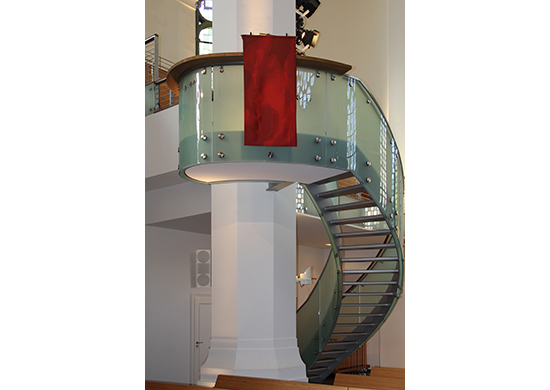Antependium. rot.
Pastor Dr. Uwe Vetter
Kirchen predigen, durch Bibelworte, durch Klänge, durch das, was im Gottesdienstablauf sichtbar wird. Auch Gebäude senden eine Botschaft, der Gottesdienstraum spricht. Zur Verkündigung des Evangeliums gehören auch die liturgischen Farben, die den christlichen Jahreskreis strukturieren. Sie markieren die Fest- und Fastenzeiten und heben einzelne hohe Feiertage im Kalender hervor. Weiß ist die Christusfarbe, grün die Farbe des Lebens. Schwarz die Farbe der Trauer, violett symbolisiert die Bußzeiten des Jahres, und rot ist die Farbe der Kirche.
Zu Pfingsten und zum Reformationstag am 31. Oktober werden rote Antependien (lateinisch: ›Vorhang‹) vor den Altar und ans Predigtpult gehängt, um an die Urglut des Glaubens zu erinnern. Der Geist des HERRN erscheint in der Pfingstgeschichte wie Feuer, das vom Himmel herabregnet und Menschen erfasst und sie wie Lohen einhüllt. Das Geistfeuer ist nicht zu verwechseln mit den zerstörenden Feuersbrünsten, die Landschaften und Städte verwüsten können. Es ist vielmehr von der Art der Flammen am brennenden Dornbusch 2. Mose 3, es ist Feuer, das nicht verzehrt, und aus dem die Stimme Gottes spricht. Die Farbe Rot symbolisiert Gottesgegenwart, die anfeuert, die Begeisterung entfacht, die Urkräfte weckt und den Glauben mit dem Anfang, mit der Schöpferkraft Gottes verbindet. Zugleich ist das Rot ein Leuchtfeuer, eine Peilmarke und eine Fackel, die den Gläubigen den Weg leuchtet. Beide Motive – Urkraft und Weggeleit – vereinigen sich in der biblischen Geschichte von der Wüstenwanderung des Volkes Israel, wo es heißt, dass Gott der HERR Seinem Volk einen Weg bahnte und es selbst
begleitete: am Tag als Wolkensäule und in der Nacht als Feuerfontäne. Beide Formen sind Naturerscheinungen entliehen, wie man sie von einem ausbrechenden Vulkan kennt, der des Nachts rotgoldene Lava auswirft und tagsüber von Aschewolken umgeben ist, unter denen sich glühendes Magma bewegt. Neues entsteht, aus der Tiefe des Ursprungs, das ist die Botschaft. Wenn wir die neuen Antependien einweihen, achten Sie auf das rote Motiv, das wie lohende Flammen über glühenden Scheiten brennt und sich fast zu bewegen scheint.
---
Antependium. red.
Pastor Dr. Uwe Vetter
Churches preach through the words of the Bible, and through sounds and what is manifest in church services. Buildings too send out a message; places of worship speak.
In the proclamation of the Gospel the liturgical colours also play an integral part, giving structure to the Christian year. They symbolise seasons of celebration and fasting and highlight the individual holy days in the Christian calendar: white is the colour of Christ, green of life, black of deep sorrow. Violet symbolises periods of repentance throughout the year, and red is the colour of the Church.
At Pentecost and on Reformation Day, 31 October, red ‘antependia’ (Latin for a “hanging” or parament) hang in front of the altar and pulpit to remind us of the original fire of faith. In the Pentecost story the spirit of the LORD appears in the form of fire raining down from the heavens, touching the people and enveloping them in its glow. But His fire is clearly distinct from any destructive inferno that wreaks desolation on landscapes and towns. Like the flames on the burning bush of thorns (2 Moses 3), its fire consumes nothing, and from it emanates the voice of God. The colour red symbolises the nearness of God, spurring us on, enthusing us, arousing elemental powers and merging faith with the beginnings, with the creative power of God. At the same time red is a beacon colour, a guiding light, a torch that lights the way for believers. These two motifs – that of fire as both elemental force and guiding light – are united in the biblical story of the people of Israel. As they crossed the desert on their exodus, it is said that God the LORD cut a path for them and guided them, during the day as a pillar of cloud and at night as a pillar of fire. Both of these forms are based on natural phenomena familiar from volcanic eruptions: the volcano spews its golden-red lava out in the darkness. It is surrounded during the daytime by a cloud of ash under which the glowing magma flows. The message is that from the depths of our origins something new emerges. When we bless our new paraments, look carefully at the motif of red that burns like flames over glowing firewood, almost appearing to move.





